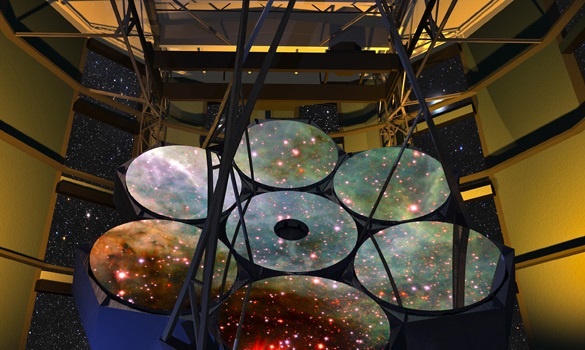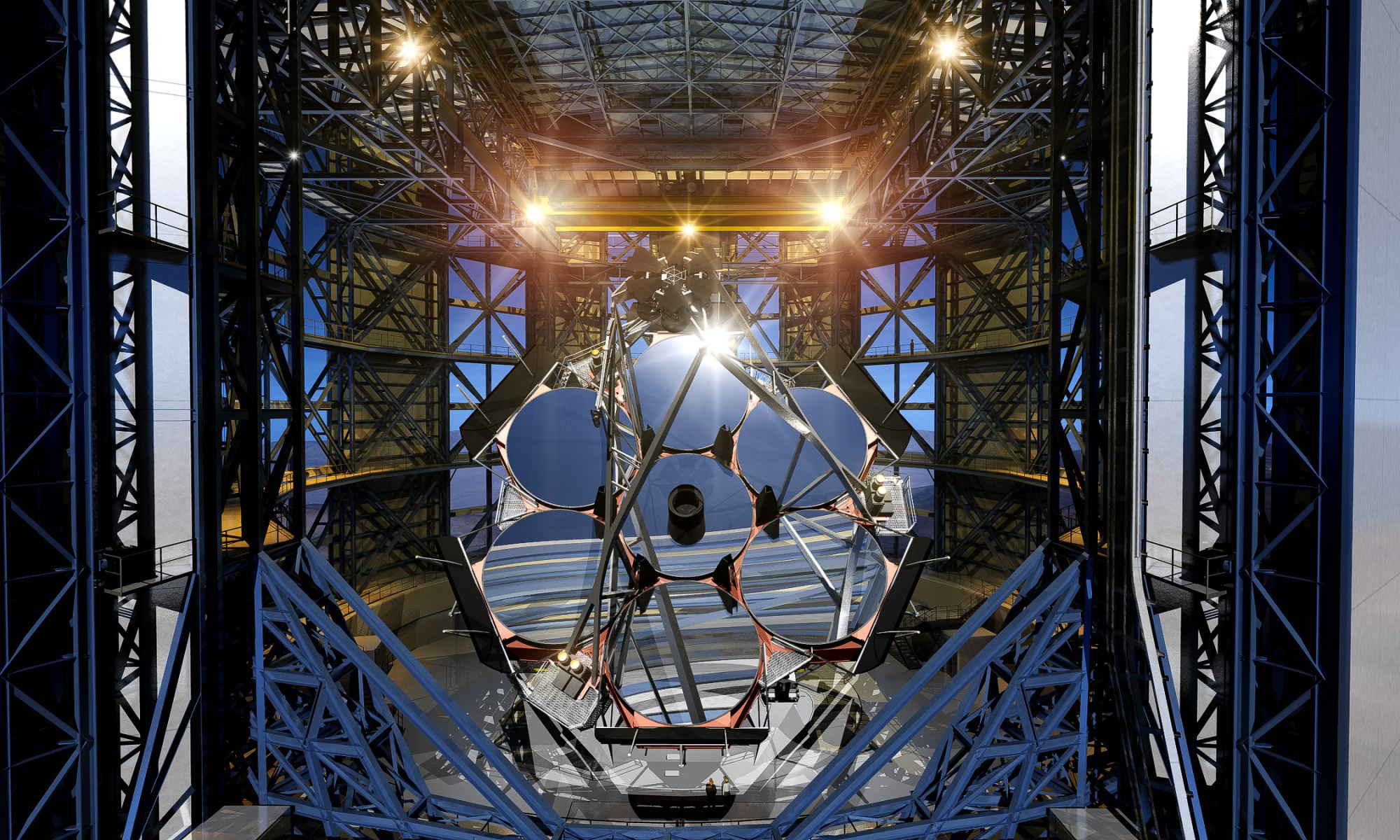By 2029, the Giant Magellan Telescope (GMT) in northern Chile will begin collecting its first light from the cosmos. As part of a new class of next-generation instruments known as “extremely large telescopes” (ELTs), the GMT will combine the power of sophisticated primary mirrors, flexible secondary mirrors, adaptive optics (AOs), and spectrometers to see further and with greater detail than any optical telescopes that came before.
At the heart of the telescope are seven monolithic mirror segments, each measuring 8.4 m (27.6 ft) in diameter, which will give it the resolving power of a 24.5 m (80.4 ft) primary mirror. According to recent statements from the GMT Organization (GMTO), the University of Arizona’s Richard F. Caris Mirror Lab began casting the sixth and seventh segments for the telescope’s primary mirror (which will take the next four years to complete).
The seven mirror segments that make up the GMT are among the largest stiff monolith mirrors in the world. In their final configuration, the six off-axis segments will surround one central on-axis segment, giving it a primary mirror capable of collecting light from a surface area measuring 368 square meters (~1200 ft2). It will also have resolution power 10 times greater than that of the Hubble Space Telescope (HST).

As James Fanson, the GMT Project Manager, said in the GMTO press release:
“The most important part of a telescope is its light-collecting mirror. The larger the mirror, the deeper we can see into the universe and the more detail we can observe. The Giant Magellan Telescope’s unique primary mirror design consists of seven of the world’s largest mirrors.
“Casting the sixth mirror is a major step toward completion. Once operational, the Giant Magellan Telescope will produce images ten times sharper than the Hubble Space Telescope. The discoveries these mirrors will make will transform our understanding of the universe.”
The casting process is performed at the Richard F. Caris Mirror Lab, which is overseen by the University of Arizona, in Tuscon, AZ. It begins with nearly 17.5 metric tons (38,490 lbs) of high-purity borosilicate glass (aka. E6 glass) which is then melted by the world’s only spinning furnace. This “spin cast” process heats up the glass until it liquefies, and is also what gives the segments their special parabolic shape.
At its peak temperature (an event known as “high fire”), the furnace spins at a rate of 5 rpm, heating the glass to 1,165 °C (2,129 °F) for about five hours. The sixth and seventh mirror segments will reach “high fire” by March 6th, 2021. They will then go through the month-long “annealing” process, where the spinning furnace slows down to remove internal stresses on the glass.

This will allow the mirrors to toughen as they cool, which will continue for another 1.5 months before it reaches room temperature. Once they are finished cooling, the mirrors will be polished for two years until their surfaces reach an optical surface precision of just a few nanometers (less than one-thousands the width of a human hair). Said Buell Jannuzi, Director of Steward Observatory and Head of the Department of Astronomy at UofA:
“I am tremendously proud of how the operations of the mirror lab have adapted to the pandemic, allowing our talented and dedicated members of the Richard F. Caris Mirror Lab to safely continue to produce the mirrors for the Giant Magellan Telescope.”
At present, the first two mirror segments have been completed and are in storage at the mirror lab while segments three through six are now at various points in their production. The fifth mirror was cast in November of 2017 while the fourth mirror has completed rear surface polishing while the third is more than halfway done (and achieved 70-nanometer accuracy).
An eighth spare mirror is planned as well, which will be swapped in whenever another mirror segment requires maintenance. The mirrors are a crucial part of the optical design that allows the GMT to have the widest field of view of any ELT telescope in the 30-meter (~100-foot) class – like the Thirty Meter Telescope (TMT) that is currently under construction at Mauna Kea, Hawaii.
The secret to this is the GMT’s unique optical design, which allows it to make use of every photon of light that the mirrors collect (thereby ensuring an unprecedented level of optical efficiency). As Rebecca Bernstein, the GMT’s Chief Scientist, explained:
“This unprecedented combination of light gathering power, efficiency, and image resolution will enable us to make new discoveries across all fields of astronomy, particularly fields that require the highest spatial and spectral resolutions, like the search for other Earths.
“We will have unique capabilities for studying planets at high resolution, which is the key to understanding if a planet has a rocky composition like our Earth, if it contains liquid water, and if its atmosphere contains the right combination of molecules to signal the presence of life.”
By the late 2020s, the finished mirrors will be transported from Tuscon, AZ to the Las Campanas Observatory in the Atacama Desert of northern Chile. Located 2,500 m (8,200 ft) above sea level, this arid region is considered one of the best places to conduct astronomy on the planet. The skies are very clear at this altitude and its distance from urban centers ensures that is virtually no light pollution.
On top of that, the region’s stable airflow allows for exceptionally sharp images and the location (in the southern hemisphere) allows observatories to peer towards the center of the Milky Way. Its proximity to other observatories in the area (which conduct observations are other wavelengths) allows for easy collaboration.
This will include the European Extremely Large Telescope (EELT), which is currently being built by the European Southern Observatory (ESO) at the neighboring Cerro Armazones Observatory in Chile. It will also assist with observations conducted by the ESO’s other major observatories in the region – such as the Very Large Telescope (VLT) and the Atacama Large Millimeter/submillimeter Array (ALMA).
In addition to having viewing power 10 times greater than that of Hubble, the GMT will also have four times the power of the highly-anticipated James Webb Space Telescope, scheduled to launch on October 31st, 2021. Once operational, the GMT will explore a number of cosmic mysteries, including the early history of the Universe, the role of Dark Matter and Dark Energy in cosmic evolution, and the potential habitability of nearby exoplanets.

